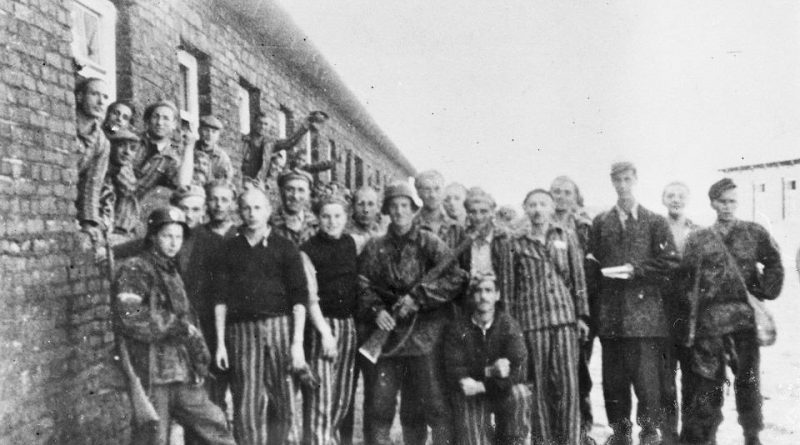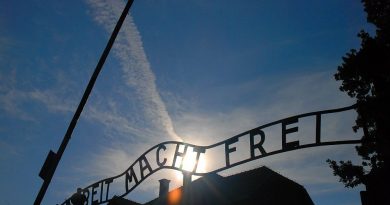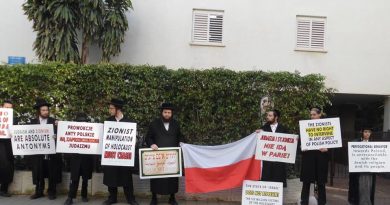The Jews and the Poles - A few facts about Poland’s WWII History
The Jews and the Poles — A few facts about Poland’s WWII History by W. Julian Korab-Karpowicz
Poland was the first country to oppose the Nazi Germany in WWII. She was attacked by the Germans on 1st September 1939 and her forces defended themselves for over one month. The outcome would be different, but unfortunately her allies France and the UK did not rush to help, and on 17th September Poland was invaded from the East by the Soviet Union. It was impossible to win against two such powerful enemies, but Poland never surrendered. A large part of the Polish armed forces and Poland’s Government were evacuated through Romania to France, and then to England, and continued to struggle against the Germans until the end of WWII.
Already in September 1939, crimes against the Polish population were committed. The German Luftwaffe bombarded towns and cities indiscriminately. The German army and security police was killing civilians and disarmed Polish soldiers in villages, especially in places where they found a strong resistance, and was hunting people who were working in local administration, like mayors and other town officials, and executing them. The Poles, like the Jews, were considered by the Nazi Germans as Untermenschen (sub-humans) to be extinguished. The goal of the Operation Tannenberg was to identify the members of the Polish middle class: public officials, scholars, actors, Catholic clergy, and to murder them. It is estimated that in the norther part of Poland called Pomerania, which was of special German interest, 36,000–42,000 Poles were killed in mass executions before the end of 1939. In the Intelligenzaktion – the action against the Polish intelligentsia in the area of Poznan about 2000 Polish intellectuals, public officials and clergy were murdered. On 9 November 1939 Professors of the Jagiellonian University, the oldest university in Poland est. in 1364, were summoned to a meeting by the head of the Sicherheitspolizei—German security police—to be immediately arrested and sent concentration camp Sachsenhausen near Berlin. They were the first Polish prisoners of this infamous German camp, which served as a model for the new extermination camps, particularly for Auschwitz, which was established in April 1940.
This is true that, especially after 1942 and the decision of Endlösung (Final Solution to the Jewish Question), the Jews were a special target for Nazi Germans and they were systematically killed in such Nazi German extermination camps as Auschwitz-Birkenau, Tremblinka, Sobibor, Belzec or Kulmhof. These camps were located in occupied Poland—the place where the majority of European Jewry was then located. But it is also true that Poles were the target of extermination as well. Since the Polish population was much larger than the Jewish, the methods employed to extinguish the Poles were to be different. The first target were prominent citizens and intellectuals, and political opposition – people suspected of underground resistance. The first mass transport to Auschwitz occurred on 14 June 1940 and included 728 Polish political prisoners and a small group of Jews. The second target of extermination was Polish people who were living in areas that were attractive for the Germans. It often happened that one would be removed from one’s house and property overnight, either to be immediately shot or sent to a concentration camp or moved to Germany as a labor worker. In the Aktion Zamosc a large area of land was cleared from Polish population simply because the soil there was good, and over one hundred thousand Poles who were removed were to be replaced by the German settlers. Families were divided and most of them, including children, were either killed or sent to Auschwitz and other camps. Several thousand young Polish children, especially those who were good-looking, with blond hair and blue eyes, were taken from their parents and sent to Germany to be Germanized. Out of those, only 800 was recovered after WWII and returned to Poland. However, it was not the German goal to murder all the Poles at once, as they were trying to do with the Jews, but in stages. The reasons were economic. The German war machinery needed production, so the Germans could not afford to kill all Polish factory workers, and it needed food, so that they could not immediately kill all Polish farmers. Although methods of genocide were different, the Nazi German goals with regard to the Jewish and Polish population in Poland were in fact the same—total extinction.
From the beginning of WWII there was an underground Polish military resistance against the Germans. The strongest underground military organization was called the Home Army (AK). The AK was aware that the first target of the mass extermination for the Nazi Germans was the Jews. Therefore, in collaboration with the Polish government in exile, it established a special unit, Zegota, whose role was to do everything that could be done to save Jewish lives. It is estimated that they saved about fifty thousand. In each society, there will be some collaborators. In the occupied Poland, there were very few. On the contrary, there was widespread resistance and substantial help to the Jews, which was extremely dangerous because of the German occupation law that hiding Jews carried death penalty. Contrary to this jurisdiction, the AK declared that if someone would help the Germans to kill the Jews by, for example informing where they were hidden, such a person would be sentenced to death. Moreover, the AK made sure that information about the German crimes against the Jews are known to the world. Of the special importance were the reports of Karski.
Jan Karski, AK officer, and later professor at Georgetown University, together with his brother, head of the Warsaw Police, which was established by the Germans, but whose many members collaborated with the underground, prepared three reports on the situation in occupied Poland. He was twice smuggled into the Warsaw Ghetto and once entered the Izbica Ghetto disguised as a guard. Especially significant was his third report, in which Karski described the extermination of the Jews. One the basis of this report, on 10 December 1942, the Polish-government-in-exile in London prepared a diplomatic note that was sent to twenty-six countries, including the UK and USA, that signed the Declaration of the United Nations. This was the first official report informing the governments and public opinion in the West about the extermination of the Jews and the horrors of the Holocaust. Karski was then transported secretly abroad and sent to Washington to tell the American Government and Jewish-American organizations about the Jewish genocide. On 28 July 1943, he met with the US president Franklin Roosevelt. He described the situation in Poland and proposed some military actions against Germany, like bombing roads and installations in the camps, to obstruct the German work of the Jewish genocide. However, surprisingly, no one seem to believe in what he had to say, and there was no practical response to his report. His testimony is brilliantly conveyed in his book: Jan Karski, Story of a Secret State. This book of the great eye-witness of the heroism of the Polish resistance and the Nazi German brutality should be widely read to dispel falsehoods about of WWII.
Today Auschwitz is a symbol of the Jewish Holocaust. It is true that the Poles were mainly in Auschwitz I, which was a concentration camp, whereas the majority of the Jews was directed straight to Birkenau, which was a death camp. However, since they were both classified as Untermenschen, both the Jews and the Poles would ultimately face extermination. The Jews had to wear the Star of David as the sign of their distinction; the Poles had to wear a triangle with P sign. They were equally brutally treated, deprived of their humanity, and both condemned to death. In the concentration and labor camps they could live longer, in the death camps they were subjected to immediate murder. But someone can make the following objection. If the Jews and the Poles were equally the target of Nazi German extermination, why were there some Poles that cooperated with the Germans? Why was there Jedwabne? First, the Jedwabne case, in which about 40 Poles were involved and about 340 Jews were killed, and which described in the well-known book of Jan Gross, Neighbours, has not been properly documented by Gross and not yet fully investigated. According to witnesses, the Polish neighbors who helped the Germans to burn some hundred Jews in a barn, were in fact summoned to this action by German police forces. They were not doing this willingly. Some of them escaped from the site in order not to be involved. The German police was certainly present, although its full involvement is still not fully clarified. Now, we can turn this question to the other side and ask why were there so many Jews who cooperated with the Germans? In contrast to those Polish people from Jedwabne who were probably forced or at least encouraged to act against the Jews, the members of the Judenrat and Jewish police, who cooperated with the Nazis, were doing this willingly. As Hannah Arenth powerfully stated in her book Eichmann in Jerusalem and as it is sown in many documents, they were seriously involved in crimes by selecting and sending thousands of their neighbors to death, hoping perhaps to save their lives, but in the end, this was a false hope.
There will always be some people who because of their weak character or other reasons, agree to cooperate with the enemy. But Poland did not agree to surrender to the Germans, and no collaborator government was ever formed. Although there were some traitors, the Polish police in occupied Poland largely served the underground resistance, for which the best proof is perhaps the Karski reports. For five long years, Polish people did everything that was possible to resist the Nazi German occupation during WWII. By losing 20 percent of her population, Poland is in fact the greatest victim of the war. And even if some Polish people were for some reasons anti-Semitic before the war, this feeling disappeared during the war. The prevailing attitude was awareness of the Jewish genocide and of the common suffering.
On a personal note, the brother of my mother — my uncle, Wieslaw Miller, was a part of the resistance, and with my mother, who was a small girl at that time, smuggled bread to the Warsaw Ghetto. He was killed during the Warsaw uprising in August 1944. After the uprising fell and Warsaw was almost completely destroyed, my mother with the rest of the family was sent by the Germans to the Henningsdorf labor camp near Berlin. There she was subjected to numerous insults and severe beatings. If the war had lasted a few months longer, she would not have survived the camp conditions, and I would not have been born. She died at a relatively young age because of the illness she got in the camp.
For future Jewish-Polish relationships, it is very important that we all have a good understanding of our history. Israel needs friends and Poland, where the Jews lived in relative peace and security for centuries, can be one, but friendship requires a common basis, and this is historical truth and mutual understanding.
Acknowledgements. The article was published on March 3, 2018 by The Jerusalem Post.
W. Julian Korab-Karpowicz is a philosopher and political thinker, professor at Lazarski University in Warsaw and Zayed University in Dubai. He received his doctorate from the University of Oxford. In the early 1980s, he was a student leader in Poland’s Solidarity movement, and in 1991 was elected Deputy Mayor of Gdansk. He was also a diplomat and an ethics expert of the European Commission. He has taught at many universities. He is the author of several books, including Tractatus Politico-Philosophicus: New Directions for the Development of Humankind.
Image: Jewish prisoners of Gęsiowka, a German-Nazi Camp in Warsaw liberated in August 5, 1944 with Polish soldiers from Battalion “Zośka” of Home Army in the beginning of Warsaw Uprising. Batalion Zośka (pronounced Zoshka) was a Scouting battalion of the Polish resistance movement organisation - Home Army (Armia Krajowa or “AK”) during World War II. Source: Wikipedia, public domain.



